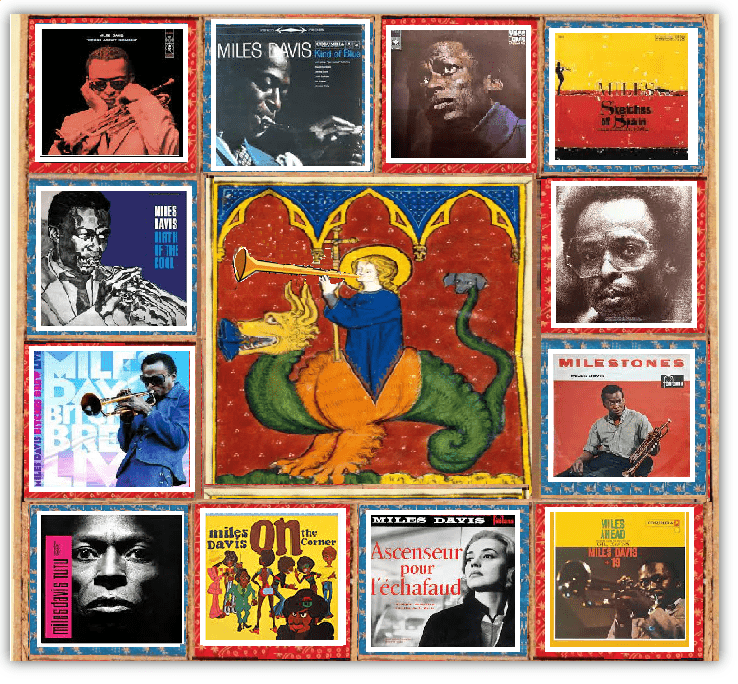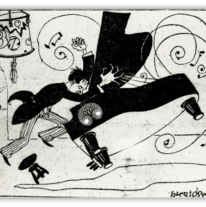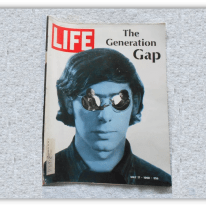In a previous post, there was some discussion about an article or even a series about Miles Davis’ vast discography.
After a few false starts, I realized that a complete and thorough review of Miles Davis’ discography would be too large a task. I gave the entire project some more thought and decided to keep it simple: give the members of this community an entry point–and a little guidance.
With this in mind, I decided that I would compile a catalogue, with no more than one sentence per entry.
I thought this would provide a summary of each album that would prompt you to explore whatever caught your interest. I also decided that the form of the catalogue would be something fun.
For whatever reason, the medieval bestiary popped into my mind.
A few introductory points:
• The entire discography is not captured here. There is just so much. While the majority of my entries are studio albums, I tried my best to include live albums and a soundtrack.
• Miles Davis was at the center of a constellation of incredible jazz musicians. There is an argument that his greatest contribution is the ability to locate and support talent…
… John Coltrane. Cannonball Adderley. Bill Evans. Paul Chambers. Jimmy Cobb. Wayne Shorter. Herbie Hancock. Tony Williams. Ron Carter. Chick Corea. John McLaughlin. Dave Holland. Joe Zawinul. Dave Liebman. Gary Bartz. Reggie Lucas. Pete Cosey. Mike Stern.
The list goes on and on. As we appreciate Miles Davis’ music, we should not forget all the amazing musicians who played with him. If you like someone’s playing on a record, go ahead and explore his solo work.
• There are parts of Miles Davis’ biography/life that do not reflect well on him as a person. The praise that I (and others) give to him and his music in no way condones the bad things he did.
And now, the Miles Davis Bestiary:

Cookin’ Relaxin’ Workin’ Steamin’: the bee(s).
Four albums recorded in two days that keep on giving.

The Birth Of The Cool: the bear.
A huge, powerful sound that barrels down on you.

The Musings of Miles: the goat.
Strong and sturdy playing throughout.

Bags Groove: the swan.
This sounds like the end of an era.

Round About Midnight: the owl.
A panoramic view of all things nocturnal.

Miles Ahead: the heron.
The wisdom and sound of a bygone era.

Ascenseur pour l’echafaud: the nightingale.
A song of sorrow and death.

Milestones: the dog.
The title track alone will make this your new best friend.

Porgy and Bess: the crow.
A soundtrack that continues to endure.

Kind of Blue: the unicorn.
No one will ever capture anything like this.

Sketches of Spain: the horse.
Powerful, majestic and beautiful.

Someday My Prince Will Come: the frog.
Get close to this one and it will surprise.

ESP: the sparrow.
Swift and unpredictable.

Miles Smiles: the eagle.
The pinnacle of the Second Great Quintet’s playing.

At Plugged Nickel: the snake.
Before you know it, you are wrapped up in these incredible performances.

Nefertiti: the cat.
This is the sound of something surreptitious, ready to pounce.

Filles de Kilimanjaro: the fox.
The playing on this album can best be described as crafty and playful.

In a Silent Way: the kingfisher.
This is the sound of the song that can calm the seas.

Bitches Brew: the raven.
After this one, jazz (as everyone knew it at the time) was nevermore.

Jack Johnson: the dragon.
Once you wake this one up, get out of the way!

Live-Evil: the manticore.
A composite of various forms of aggression.

On The Corner: the chameleon.
The textures and sounds never stop shifting and changing.

Get Up With It: the blue whale.
This double album is a behemoth, in both sound and composition.

Agartha: the mole.
The entire performance feels as though the band is digging to the center of the earth.

Dark Magus: the black panther.
The proto-sound of the jungle.

Tutu: the phoenix.
A resurrection of sorts.
Epilogue:
For those looking for a starter pack of sorts, check out these individual tracks.
Move (from The Birth of the Cool)
It Never Entered My Mind (from Workin‘ with the Miles Davis Quintet)
Milestones (from Milestones)
Footprints (from Miles Smiles)
What I Say (from Live-Evil)
I hope you found this somewhat helpful. I look forward to discussing this music with all of you.
Let the author know that you liked their article with a “heart” upvote!





Thank you, minor major 7th. This is less intimidating than looking at Miles Davis’ Wikipedia page. His collaboration with Green Gartside of Scritti Politti fascinates me. I blew my allowance on Provision. I think Miles Davis’ name was on the back of the cassette: “Oh, Patti(Don’t Feel Sorry for Loverboy)” featuring Miles Davis. I could be wrong. But I remember thinking to myself: That Miles Davis? I guess Davis really loved Cupid and Psyche ’85 to cover “Perfect Way”. The experience must have freaked Green Gartside out because the music world had to wait eleven years for Anomie and Bonhomie.
You are most welcome, cappie.
Back at the mothership, I once commented that Miles in the 80s is Miles in “comfortable genius” mode. He was doing whatever he wanted, knowing he had made his masterpieces.
The 80s stuff is not terrible. There are some great grooves there. You just have to get past the production (the drums and synths, in particular) that make it all sound dated.
I had to look up the definition of “bestiary,” but what a cool way to demystify Davis’ catalog. Nice job!
I sort of just buy whatever titles I see used at a good price and never know what to expect, which is how I ended up with On The Corner. It’s a great record but not one I can recommend as an entry point. It’s too dense, all rhythm and little melody. It rocks, but it can be difficult listening.
Thank you, virigindog.
I still don’t know why the bestiary came to mind, but here we are.
On the Corner may be third to Kind of Blue and Bitches’ Brew as to how much has been written about it. I know it can be a polarizing record. I’m with you. It rocks, but its not an entry point by any means.
Thank you, mt58!
I could not have imagined the post looking this great. A huge virtual hug to you.
Thanks, mM7 – It was great to have such interesting and imaginative content with which to put up a little “window dressing.” I’m glad that you liked it.
Are these woodcuts? Or art inspired by woodcuts? I remember this look from the cover art for The Water Walk’s “Thingamajig”.
I didn’t know too much about the subject until I took the dive on harvesting the artwork.
While I am certain that I’ve seen this type of art in wood cut, just about everything that you see in the article was either a painting or woven cloth.
An inventive way of plotting a course into an extensive back catalogue, round of applause for the creativity involved. Cappie already got there with the word I was going to use when seeing the lengthy list of releases; ‘intimidating’. I’ll be honest, Miles isn’t someone I’ve considered exploring but I might just give that starter pack a go and those one line descriptions are pretty intriguing. Thanks mm7th
You’re welcome, JJ.
I hope you do dive in. Let us know what you think.
Beautiful post!
Miles has so much amazing stuff. Certainly not all of it is friendly, but it’s all worth a listen. My entry point was Kind of Blue, which I liked immediately, though I found Coltrane’s playing somewhat jarring. Of course, given that my second purchase was Bitches Brew, the sounds of Kind of Blue instantly seemed quite accessible in comparison. 🙂
I’ve since acquired a ton of his stuff, but I see 5 or so albums here that I don’t have and should check out. Thanks for some fun homework!
Thank you, Phylum.
It was around the release of Kind of Blue (or earlier) that the “sheets of sound” technique was attributed to Coltrane. It can be jarring–and it still is to my ears. Coltrane’s aim in the technique was to effectively “wash” all the harmonic possibilities over a chord, so that the listener would stop and consider how Trane had superimposed different harmonies over one chord.
The technique was a prelude to Coltrane’s work in free jazz and avant-garde.
Kind of Blue is known for developing the use of modes (as opposed to chords) for a composition. I will leave it to Bill to discuss modes in one of his awesome lessons. The point: Coltrane’s sheets of sounds dovetails into modal playing.
Theory aside, Kind of Blue has cemented its place in the canon. It’s funny to think how an album so very dark and cerebral has come to be seen as the entry point into the genre for so many. I love the album. It has, coincidentally, been playing in the background during special moments in my life. To my ears, Miles’ solos and Bill Evans’ playing are the highlights.
Bitches Brew was the first Miles Davis album I listened to. The title track and “Spanish Key” are the highlights. The rest of the album meanders a little too much at times. Listen to it again with a good pair of headphones and you will hear Miles whispering instructions to all the players (“keep it together like that”) or direct someone to start playing (you hear Miles say “John” on the title track around 9 minutes or so, giving John McLaughlin the go ahead to rip a killer solo). Also, the low-end, especially Bennie Maupin’s bass clarinet, acts an important “scaffolding” to all the madness.
Yeah, it was Coltrane’s boisterous playing and his modal fluidity that threw me off of Kind of Blue, at first. But don’t get me wrong, I soon came to love the album, and soon came to be in absolute awe of the juggernaut that was John Coltrane.
I guess at first I was expecting someone more like Lester Young, or Stan Getz, or Paul Desmond (though I was a jazz novice at the time so I wouldn’t have name-dropped like that). Sax work that was very cool and smooth…and for this album mostly in the minor key. But it’s not like the album was called Completely Blue! It is Kind of Blue. Thanks to Coltrane, it’s also kind of indigo, and violet, and maybe a dash of red too. That modal uncertainty is a huge part of the album’s appeal. It just goes to show that a widely popular and relatively gentle jazz album can still have some quirks up its sleeve.
Bitches Brew is an album that I tell myself I need to listen to on some sort of psychedelic…but when push comes to shove, I’ll put on In A Silent Way instead. That’s no diss, though; the world needs some giant alien miasmas of sound sometimes. I agree that the album does meander at times, but it’s such a fascinating sculpture most of the time; it really is a pleasure simply trying to wrap my head around it.
This is a super-cool marriages of words and images. It’ll persuade me to add sounds to the mix, too. Great job mm7 and mt58.
That would be “marriage,” not “marriages.”
Thank you, cstolliver.
It’s funny you mention marriages because one of my music-nerd pastimes is to conceptualize the “lineage” from modern day players back to Miles Davis.
Some examples:
Aaron Parks played with Paul Motion who played with Bill Evans who played with…Miles Davis.
Pat Metheny played with Gary Burton who played with Chick Corea who played with…Miles Davis.
Very interesting post, major minor. Jazz is one of those genres most Americans either do not understand or ignore. But among the fervent fans, it’s almost a religion.
My late uncle was a huge jazz fan and my gateway into the realm was Louis Armstrong ( his favorites were Art Baker and Bix Biederbick).
In high school int he late sixties, I was working for a big box store named Caldor (think K-Mart or WalMart before their time). Employees would get a discount on any purchases, so I would take advantage of the record department. I bought “Bitches Brew” on the review in Rolling Stone that it was a brilliant album. Listening to it, I knew it was something different but it really didn’t reach me in a musical way.
I’ve talked about how my broad collection of R&B records were on demand from the “brothers” in college, with The Temps, the Four Tops and Marvin Gaye being in great demand for loan outs but I could never get them to get into Davis as they would return the album within thirty minutes saying he was too strange for them.
An interesting point of view since it was a medium practically invented by Black artists.
I know there have been several attempts by mainstream music to bring jazz into the fold (Dazz Band “Disco Jazz” and the artists that did “Hand Upon the Torch”) but it’s been too no avail.
To most Americans, the definitive jazz song will be “Take Five” by the Dave Brubeck Trio and that was sixty years ago this year.
Thanks for bringing up and interesting but relatively ignored by the mainstream genre.
Miles Davis was to jazz what Bill Monroe was to bluegrass.
Not the he founded the whole genre like Bill more or less did, but he fostered generations of greats. Most every great jazz musician played with Miles Davis at some point, just like most every great bluegrass musician played in Bill Monroe’s band on their way to stardom.